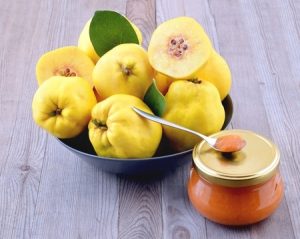Quince (Cydonia oblonga) is an attractive, medium-sized bush, even a small tree that blossoms like a rose in the late winter or early spring months. Quince leaves produce exceptional autumnal colouring and even though we grow them as ornamental thorn bushes there are some excellent varieties for fruit production. The quince is the ideal fruit tree for extending the season after the apples and pears have stopped fruiting. The fruit is used for the production of membrillo, the Spanish jelly delicacy eaten with cheese because the acid cuts the fat.

Cultivation
In cultivation, the quince is grown as a half-standard or bush tree, built on a rootstock which is either ‘Quince A’ or ‘Quince C’. A ‘Quince A’ rootstock ensures the plant is semi-vigorous and produces trees which are 3.5 to 4.5m (11½ – 14½ft) tall. The ‘Quince C’ rootstock produces a semi-dwarf shrub of 3 to 3.5m (10-11½ft) tall. The tree flowers from February to May and is reliably self-fertile. It grows ideally in fertile, deep moisture-retentive soils but is tolerant of a range. They are all reliably hardy but a warm, sunny and sheltered spot is best for fruit ripening. It is not really a shade plant and it is best to avoid frost pockets which can damage the flowers and reduce fruiting. A sheltered, sunny spot also promotes fruit ripening.
Harvesting Of Fruit
Quince fruits ripen in late October/early November but need to be left on the tree as long as possible to allow the sweetness and flavour to develop fully. Frosts are not necessarily an enemy and I tend to pick the fruit for quince jam after a few simply because the fruit will eventually rot.
The quince fruit is a soft golden, aromatic fruit. All undamaged fruits should be stored in a cool, dark place in shallow trays. No fruit should touch each other to avoid successive rotting by contact, nor should they be wrapped and it’s best not to store with other fruits.
Fruit should ‘mellow’ for six to eight weeks before use where they keep for two to three months. They are unpalatable when raw.
Quince Fruit Varieties
The best varieties are ‘Lusitanica’ (syn. ‘Portugal’) and is claimed to have the best-flavoured fruit. It is pear-shaped, 13-18cm long, deep yellow and covered with a soft grey down. The tree is more vigorous than other cultivars, but generally not as hardy as some. Other varieties such as ‘Champion’ produce a good crop of large, pear-shaped rounded fruit and are bright yellow, 10cm in diameter with a delicate flavour. The ‘Vranja Nenadovic’ is a golden, pear-shaped aromatic fruit of 13-18cm long and highly regarded for its balanced flavour. It fortunately begins its fruiting on relatively younger trees than the other. The ‘Meech’s Prolific’ cultivar is also pear-shaped with golden yellow fruits with perhaps the finest flavour of all. The fruit is 13-18cm long and its flowers are large, prolific and provides exceptional growth. The ‘Serbian Gold’ is apple shaped with a good flavour.
Sibley’s Patio quince is ideal for containers and is a new, dwarf cultivar growing to 1.2m (4ft).
The fruit complements the Medlar.
Leave a Reply